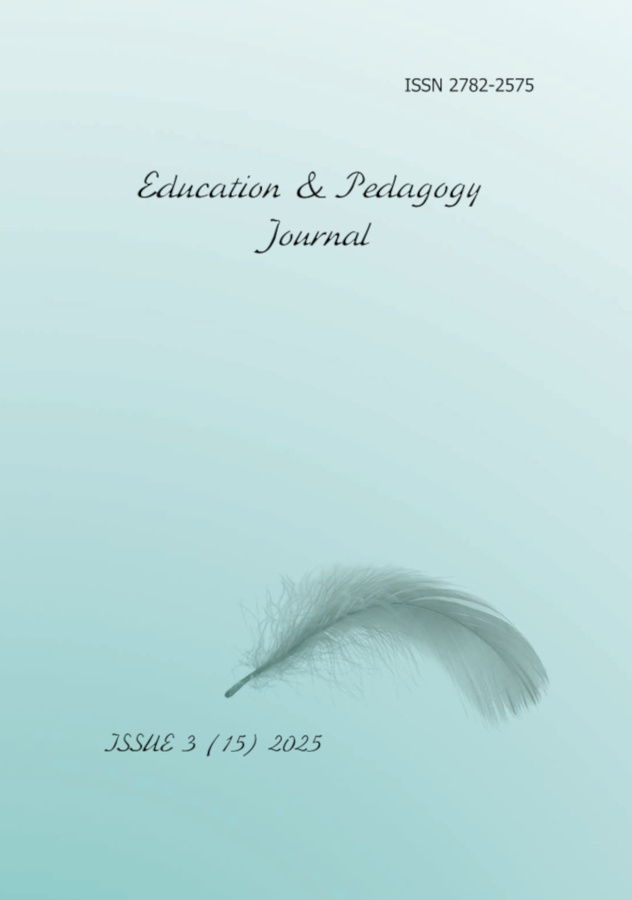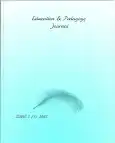VALUES AND MEANINGS THAT THE INTERIOR OF A SCHOOL CONVEYS TO A STUDENT
- Авторы: Азбель А.А.1, Илюшин Л.С.1, Самойлова Е.С.1
-
Учреждения:
- Санкт-Петербургский государственный университет
- Выпуск: № 2 (2022)
- Страницы: 42-52
- Раздел: Статьи
- URL: https://journal-vniispk.ru/2782-2575/article/view/270202
- DOI: https://doi.org/10.23951/2782-2575-2022-2-42-52
- ID: 270202
Цитировать
Полный текст
Аннотация
The article is devoted to the analysis of the elements of visual communication presented in the interiors of schools. The lack of textual solutions that meet the emotional and value-based requirements of modern students in the visual space of the school is investigated. Texts in the educational space of the school are a flexible and multifunctional tool that can be used not only to increase the school’s attractiveness but also to create an educational dialog with students and their families. Texts can promote the rules of interaction between people and society, the value of ecological behavior, the effective use of resources, respect for others, and a subjective position in educational activities. Materials and Methods. Photographs and video recordings of the visual environment of modern Russian schools served as material for study. The data was collected not only in classrooms but also in all common spaces of the school – corridors, gymnasiums, canteens, museums, libraries, staircases, and entrance areas. In some cases, the object of analysis included images and texts conveying a specific meaning. Qualitative and quantitative analysis are the main methods used in studying text solutions in educational institutions. The article proposes a classification of visual solutions used in schools (8 types of texts) and describes the group interview method as a research tool for visual solutions in schools. Fixation and attribution of school texts were conducted in interaction with adolescent students. Results and Discussion. The study reveals the content and stylistics of interior elements in modern Russian schools. The article justifies the use of School Texts to develop students’ Flexible Skills. The modern visual environment of Russian schools is largely focused on the preservation of the traditional school system. It conveys a formalized idea of school, in which learning is the main focus rather than other aspects of students’ lives and personal development. Conclusion. In order to develop and implement these solutions, it is useful to combine the efforts of professionals from the fields of design, pedagogy, ergonomic psychology, philology, and linguistics and to listen to the ideas and desires of the main subjects in the educational process – the students themselves. The study results show a lack of professional solutions in the design of modern schools. The article suggests ways to overcome these gaps through a collaborative approach to the design of the visual environment of educational institutions.
Об авторах
Анастасия Анатольевна Азбель
Санкт-Петербургский государственный университет
Автор, ответственный за переписку.
Email: a.azbel@spbu.ru
кандидат психологических наук, доцент Университетская набережная, 7/9, Санкт-Петербург, Россия, 199034
Леонид Сергеевич Илюшин
Санкт-Петербургский государственный университет
Email: l.ilushin@spbu.ru
доктор педагогических наук, профессор Университетская набережная, 7/9, Санкт-Петербург, Россия, 199034
Евгения Сергеевна Самойлова
Санкт-Петербургский государственный университет
Email: kasichk@gmail.com
магистрант Университетская набережная, 7/9, Санкт-Петербург, Россия, 199034
Список литературы
- Cook D.J. Learning Setting-Generalized Activity Models for Smart Spaces. IEEE Intell Syst., 2010, vol. 27, no. 1, pp. 32–38. doi: 10.1109/MIS.2010.112.
- Sless D. Learning and Visual Communication. New patterns of learning. Kent, Croom Helm, 1981. 208 p.
- Lola G. N. Dizajn kak kommunikativnaya praktika [Design as the communicative practice]. Vestnik Sankt-Peterburgskogo universiteta. Seriya 15. Iskusstvovedenie – Vestnik of Saint Petersburg University. Arts, 2012, vol. 2, no. 2, pp. 225–230 (in Russian).
- Fleming R.L. The art of Placemaking: Interpreting Community through Public Art and Urban Design. London, Merrell, 2007. 383 p.
- Schneider M. Do School Facilities Affect Academic Outcomes? Washington, DC: National Clearinghouse for Educational Facilities, 2002. 24 p. URL: http://www.ncef.org/pubs/outcomes.pdf (accessed 19 November 2018).
- Rautakoura A. Finlyandiya – za obuchayushchie metody budushchego [Finland features future learning methods]. Eto Finlyandiya – This is Finland, 2012 (in Russian). URL: https://finland.fi/ru/biznes-i-innovatsii/finlyandiyaza-obuchayushhie-metody-budushhego/ (accessed 20 December 2018).
- Byers T., Immz W., Hartnell-Young E. Comparative analysis of the impact of traditional versus innovative learning environment on student attitudes and learning outcomes. Studies in Educational Evaluation, 2018, vol. 58, pp. 167–177. doi: 10.1016/j.stueduc.2018.07.003
- Jamieson P., Fisher K., Gilding T., Taylor P.G., Trevitt A.C.F. Place and Space in the Design of New Learning Environments. Higher Education Research and Development, 2000, vol. 19, no. 2, pp. 221–236. doi: 10.1080/072943600445664
- Casanova D., Napoli R., Leijon M. Which space? Whose space? An experience involving students and teachers in space design. Teaching in Higher Education, 2016, vol. 23, no. 4, pp. 488–503. doi: 10.1080/13562517.2017.1414785
- Brooks D.C. Space and Consequences: The Impact of Different Formal Learning Spaces on Instructor and Student Behavior. Journal of Learning Spaces, 2012, vol. 1, no. 2, pp 1–10.
- Park E.L., Choi B.K. Transformation of Classroom Spaces: Traditional versus Active Learning Classroom in Colleges. Higher Education, 2014, vol. 68, no. 5, pp. 749–771. doi: 10.1007/s10734-014-9742-0
- Kazakova E.I. Teksty novoy prirody: problemy mezhdisciplinarnogo issledovaniya [Texts of the New Nature: Problems of the Interdisciplinary Research]. Psikhologicheskaya nauka i obrazovaniye – Psychological Science and Education, 2016, vol. 21, no. 4, pp. 102–109 (in Russian). doi: 10.17759/pse.2016210409
- Cook D.J. Learning Setting-Generalized Activity Models for Smart Spaces. IEEE Intell Syst., 2010, vol. 27, no. 1, pp. 32–38. doi: 10.1109/MIS.2010.112.
- Sless D. Learning and Visual Communication. New patterns of learning. Kent, Croom Helm, 1981. 208 p.
- Lola G. N. Dizajn kak kommunikativnaya praktika [Design as the communicative practice]. Vestnik Sankt-Peterburgskogo universiteta. Seriya 15. Iskusstvovedenie – Vestnik of Saint Petersburg University. Arts, 2012, vol. 2, no. 2, pp. 225–230 (in Russian).
- Fleming R.L. The art of Placemaking: Interpreting Community through Public Art and Urban Design. London, Merrell, 2007. 383 p.
- Schneider M. Do School Facilities Affect Academic Outcomes? Washington, DC: National Clearinghouse for Educational Facilities, 2002. 24 p. URL: http://www.ncef.org/pubs/outcomes.pdf (accessed 19 November 2018).
- Rautakoura A. Finlyandiya – za obuchayushchie metody budushchego [Finland features future learning methods]. Eto Finlyandiya – This is Finland, 2012 (in Russian). URL: https://finland.fi/ru/biznes-i-innovatsii/finlyandiyaza-obuchayushhie-metody-budushhego/ (accessed 20 December 2018).
- Byers T., Immz W., Hartnell-Young E. Comparative analysis of the impact of traditional versus innovative learning environment on student attitudes and learning outcomes. Studies in Educational Evaluation, 2018, vol. 58, pp. 167–177. doi: 10.1016/j.stueduc.2018.07.003
- Jamieson P., Fisher K., Gilding T., Taylor P.G., Trevitt A.C.F. Place and Space in the Design of New Learning Environments. Higher Education Research and Development, 2000, vol. 19, no. 2, pp. 221–236. doi: 10.1080/072943600445664
- Casanova D., Napoli R., Leijon M. Which space? Whose space? An experience involving students and teachers in space design. Teaching in Higher Education, 2016, vol. 23, no. 4, pp. 488–503. doi: 10.1080/13562517.2017.1414785
- Brooks D.C. Space and Consequences: The Impact of Different Formal Learning Spaces on Instructor and Student Behavior. Journal of Learning Spaces, 2012, vol. 1, no. 2, pp 1–10.
- Park E.L., Choi B.K. Transformation of Classroom Spaces: Traditional versus Active Learning Classroom in Colleges. Higher Education, 2014, vol. 68, no. 5, pp. 749–771. doi: 10.1007/s10734-014-9742-0
- Kazakova E.I. Teksty novoy prirody: problemy mezhdisciplinarnogo issledovaniya [Texts of the New Nature: Problems of the Interdisciplinary Research]. Psikhologicheskaya nauka i obrazovaniye – Psychological Science and Education, 2016, vol. 21, no. 4, pp. 102–109 (in Russian). doi: 10.17759/pse.2016210409
- Savinova S.V., Kharunzheva A.A. Podkhody k opredeleniyu svoystv i funktsiy vizual’nykh kommunikatsiy i ikh klassifikatsiya [Approaches to the definition of the properties and functions of visual communications and their classification]. Kontsept, 2016, vol. 18, pp. 139–146 (in Russian). URL: http://e-koncept.ru/2016/56217.htm (accessed 19 November 2018).
- Azbel’ A.A., Ilyushin L.S., Bryazgina Yu.O. Metodologiya issledovaniya tekstov, ispol’zuyemykh v oformlenii sovremennoy rossiyskoy shkoly [Methodology for the Study of Texts Used in the Design of a Modern Russian School]. Podgotovka uchitelya russkogo yazyka i literatury v sisteme vuzovskogo obrazovaniya: problemy i perspektivy: sbornik nauchnykh statey po itogam III Vserossiyskoy nauchno-prakticheskoy konferentsii [Teacher training for the Russian language and literature in the system of higher education: problems and prospects: collection of scientific articles on the basis of III Russian National Scientific-Practical Conference]. 2017. Pp. 17–22 (in Russian).
- Sanoff H. Democratic Design. Participation Case Studies in Urban and Small Town Environments. 2010 (Russ. ed.: Sanoff G. Souchastvuyushchee proektirovanie. Praktiki obshchestvennogo uchastiya v formirovanii sredy bol’shih i malyh gorodov; per. s angl.; red.: N. Snigireva, D. Smirnov. Vologda, Proektnaya gruppa 8, 2015. 170 p.).
- Chen S.Y., Kuo H.Y., Hsieh T.C. New literacy practice in a facebook group: The case of a residential learning community. Computers & Education, 2019, vol. 134, pp. 119–131. doi: 10.1016/j.compedu.2019.01.008
- Lola G.N. Obrazovaniye dizaynera: ot tekhnologii k metodologii [The education of a designer: from a technology to the methodology]. Vestnik Sankt-Peterburgskogo universiteta. Seriya 15. Iskusstvovedenie – Vestnik of Saint-Petersburg University. Arts, 2013, vol. 3, no. 4, pp. 182–191 (in Russian)
- Consalvo A.L., David A.D. Writing on the walls: Supporting 21st century thinking in the material classroom. Teacher and Teaching Education, 2016, vol. 60, pp. 54–65. doi: 10.1016/j.tate.2016.08.005
- Reinius H., Korhonen T. & Hakkarainen K. The design of learning spaces matters: perceived impact of the deskless school on learning and teaching. Learning Environ Res, 2021, vol. 24, pp. 339–354 https://doi.org/10.1007/s10984-020-09345-8 (accessed 19 June 2022).
- Szpytma C., Szpytma M. School architecture for primary education in a post-socialist country: A case study of Poland. Comp. A J. Comp. Int. Educ., 2020, 1–24. https://doi.org/10.1080/03057925.2020.1777843 (accessed 15 June 2022).
- Sokolova M.A. “Shkola sredovogo sushchestvovaniya”: prostranstvo, kak glavnyy faktor obucheniya [“School of Environment Existence”:Space, as Main Factor of Educating]. Architecture and Modern Information Technologies, 2018, no. 3(44), pp. 362–376. (in Russian). URL: http://marhi.ru/AMIT/2018/3kvart18/22_sokolova/index.php (accessed 15 June 2022).
- Le-van T.N., Yakshina A.N., Filatova B.A., Rodionova A.N., Gurariy L.V. “Model’ souchastvuyushchego proektirovaniya shkol’nyh dvorov: soavtorstvo detey, pedagogov i roditeley” [Model of Participatory Design of Schoolyards: Collaboration of Children, Teachers and Parents as Co-authors]. Vestnik MGPU. Seriya: Pedagogika i psihologiya, 2020, no. 2(52). pp. 55–69. doi: 10.25688/2076-9121.2020.52.2.06 (in Russian).
- Shkola № 17. Garderob. Kak bez masshtabnykh izmeneniy preobrazit’ shkol’noe prostranstvo. design4school URL: https://www.design4school.ru/portfolio/page/school17 (accessed 20 June 2022).
- Yasvin V.A. Issledovaniya obrazovatel’noy sredy v Otechestvennoy psihologii: ot metodologicheskih diskussiy k empiricheskim rezul’tatam. Izvestiya Saratovskogo universiteta. Novaya seriya. Seriya: Filosofiya. Psihologiya. Pedagogika, 2018, vol. 18. no. 1, pp. 80–90. doi: 10.18500/1819-7671-2018-18-1-80-90. EDN XMOJLV. (in Russian).
Дополнительные файлы







